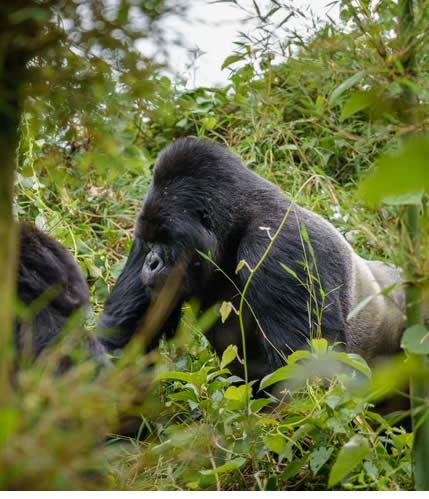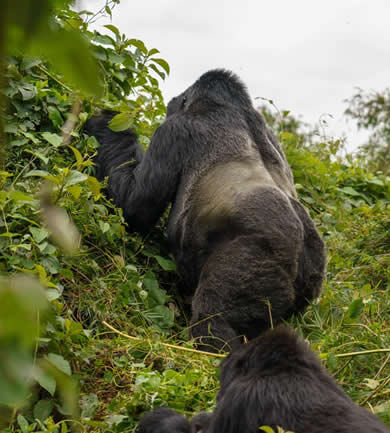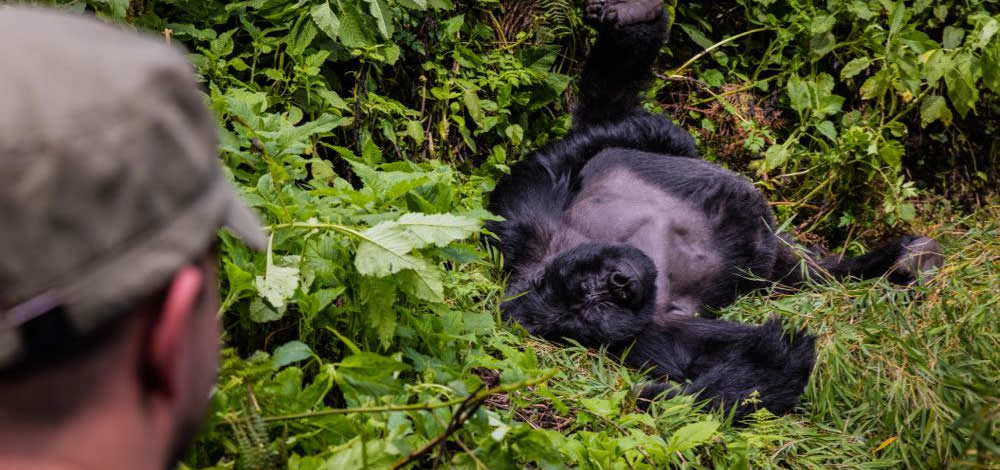Silverback gorillas are the supreme leader and protector of a group of gorillas in the jungle forest. Today there over 15 habituated gorilla families in Bwindi national park, 1 habituated gorilla group in Mgahinga, and over 15 habituated gorilla families in Rwanda Volcanoes national park. Each gorilla family is headed by a silverback gorilla summing to over 50 existing silverback gorillas in Africa. Some families comprise of more than 1 silverback gorilla and on rare accession live in harmony for a long time.

While the Silverback is an influential leader, he and his family face various challenges that threaten its survival and that of the group it defends. The dense forests where they reside provide a sanctuary for these gorillas, but human activities and natural threats continually put their existence at risk. Understanding these challenges is vital to appreciating the Silverback’s role and the conservation efforts needed to protect these magnificent animals.
Threats to Silverback gorillas
- 2 Silverbacks in the same gorilla family
- Gorilla Habitant loss
- Gorilla Poaching
- Gorilla Diseases and Infections
- Internal gorilla conflits
Two Silverbacks in 1 gorilla family
Silverback at the back of a mountain gorilla represents maturity, independency and leadership. Just like in human run families, a son at certain age signifies that he must make his own family and live independently to head and protect his own family. Rare do silverbacks coexist in 1 gorilla family for long in peace. Oftentimes they fight ending up splitting the group for each family to keep some members.
Habitat Loss
Habitat loss is one of the most significant threats to silverbacks and their families. As human populations grow, there is increasing pressure to convert forest land into agricultural fields, human settlements, and infrastructure. This encroachment reduces the available habitat for gorilla families and leads to habitat fragmentation, forcing groups to live in isolated forest patches. For the Silverback, this creates an additional difficulty in navigating safe routes foraging and protecting his family from the dangers of shrinking territories.
Poaching
Poaching, although illegal, remains a persistent threat. While gorillas are not typically hunted for meat, they can become unintended victims of traps and snares set for other animals. A silverback’s protective nature makes him especially vulnerable, as he often places himself between his family and danger. Injuries from snares can be severe, limiting his ability to forage, protect the group, or maintain his dominance.
Disease and infections
The disease also poses a significant risk to silverback-led families. Mountain gorillas share about 98% of their DNA with humans, making them susceptible to many of the same diseases. Human-wildlife contact, mainly through tourism or nearby human communities, increases the risk of transmission of illnesses such as respiratory infections. The Silverback, as the leader, is responsible for guiding the group to healthier, safer areas, but even his vigilance cannot fully protect them from these invisible threats.
Internal Gorilla Group Conflict
Inter-group competition can be another challenge for silverbacks. Conflicts between rival groups, especially during encounters in overlapping territories, can lead to physical confrontations. These skirmishes are dangerous for the silverback, as his role is to defend his family, sometimes at significant personal risk. An injured silverback may struggle to continue providing the leadership and protection that his family relies on, potentially resulting in shifts in group dynamics or even the fragmentation of the troop.
What Happens When a Silverback is Lost?
The death or departure of a silverback has profound implications for the dynamics and future of the gorilla family. Given his role as the leader, protector, and central figure in maintaining harmony, the silverback’s absence can leave the family vulnerable and uncertain. What happens next largely depends on the group’s composition and the circumstances surrounding the loss.
In many cases, the loss of a silverback creates a power vacuum that needs to be filled to ensure the family’s continued survival. If the family includes a mature or nearly mature male, known as a blackback, he may step up to take on the role of the new silverback. This transition can be complex, as the blackback must prove his ability to lead and protect the group. The success of this transition often depends on how well the previous Silverback mentored the Blackback. If the deceased Silverback had spent time grooming his successor and teaching him the skills needed to lead, the group would have been more likely to remain stable during the change in leadership.
When there is no suitable successor within the group, the family faces more significant uncertainty. Without a silverback, the females and young become more susceptible to external threats, such as attacks from rival males or predators. In some cases, the family may fragment, with females and their offspring seeking out other groups led by established silverbacks. This splintering can weaken social bonds and reduce the overall genetic diversity within the gorilla population, impacting conservation efforts.
Rival males, mainly solitary males known as lone silverbacks, may attempt to take over the group. When this happens, the new silverback often asserts his dominance, which can involve aggressive displays or even infanticide — the killing of infants sired by the previous silverback. While this behaviour may seem brutal, it is a natural way for the new leader to establish his lineage and ensure that the family’s resources are dedicated to his offspring. This period of upheaval can be traumatic for the group, especially for the mothers, but it eventually leads to reforming the social structure under the new Silverback’s leadership.
Despite these challenges, mountain gorilla families are remarkably resilient. Over time, a new silverback — whether from within the group or an external contender — can restore the stability and order that the family needs to thrive. The group’s ability to adapt and reorganise after the loss of a silverback underscores the importance of this role in maintaining the delicate balance of gorilla society. It also highlights the critical nature of conservation efforts focused on protecting silverbacks, as their survival is directly tied to the health and cohesion of the gorilla family.
Conservation Spotlight: Protecting the Silverbacks and Their Families
The conservation of mountain gorillas, particularly the silverbacks who serve as the cornerstone of their families, has been an ongoing priority in various game parks and reserves all over Africa. These magnificent creatures once faced the brink of extinction due to habitat loss, poaching, and disease. Their numbers have increased positively thanks to concerted conservation efforts, although they remain critically endangered. Protecting silverbacks and their families is central to preserving the species as a whole.
One of the most effective conservation measures has been establishing protected areas, such as Bwindi Impenetrable National Park in Uganda and Volcanoes National Park in Rwanda. These parks provide safe havens where mountain gorillas can live and roam without the immediate threat of human encroachment. Conservation organisations work closely with local governments to enforce anti-poaching laws and create buffer zones around these habitats, reducing the risk of illegal activities that can harm gorilla populations.
src=”https://www.wildugandasafaris.com/wp-content/uploads/2022/09/gorillas-mgahinga.jpg” alt=”silverback gorilla in Bwindi” />
Tourism, particularly gorilla trekking, is crucial in funding conservation efforts. The revenue generated from trekking permits is reinvested into the parks, providing resources for anti-poaching patrols, veterinary care, and community development projects. However, these programs are carefully managed to minimise human impact on the gorillas, with strict guidelines on the number of visitors, duration of treks, and distance maintained from the gorillas to reduce the risk of disease transmission. This sustainable tourism approach raises awareness and provides local communities with economic incentives to protect gorilla habitats.
A critical aspect of conservation efforts is monitoring and caring for gorilla families. Conservationists and researchers frequently conduct field observations, tracking silverbacks’ movements and health status and their groups. In cases where a silverback or other group member is injured or falls ill, veterinary teams, known as Gorilla Doctors, intervene to provide medical care. These interventions have been vital in managing disease outbreaks and treating injuries caused by snares, directly contributing to the survival and well-being of the gorilla population.
Conservation programs also engage local communities, recognising that the future of mountain gorillas depends on the people who share their environment. Education and community-based initiatives aim to promote coexistence, reduce human-wildlife conflict, and provide alternative livelihoods that lessen the need for activities like deforestation or poaching. By involving locals in conservation efforts, these programs create a sense of stewardship and shared responsibility for protecting the gorillas.
The success of these conservation efforts is most visible in the presence and health of the silverbacks. As the keystone of gorilla families, their protection ensures the survival of the broader population. When silverbacks thrive, they lead their families through the forests, nurture the young, and pass down the knowledge essential for the group’s continuity. Therefore, the ongoing work to safeguard mountain gorillas is, in many ways, a mission to preserve the Silverbacks’ strength, wisdom, and legacy.


